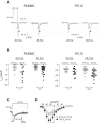Transcriptional regulation of α1H T-type calcium channel under hypoxia
- PMID: 25099734
- PMCID: PMC4187058
- DOI: 10.1152/ajpcell.00210.2014
Transcriptional regulation of α1H T-type calcium channel under hypoxia
Abstract
The low-voltage-activated T-type Ca(2+) channels play an important role in mediating the cellular responses to altered oxygen tension. Among three T-type channel isoforms, α1G, α1H, and α1I, only α1H was found to be upregulated under hypoxia. However, mechanisms underlying such hypoxia-dependent isoform-specific gene regulation remain incompletely understood. We, therefore, studied the hypoxia-dependent transcriptional regulation of α1G and α1H gene promoters with the aim to identify the functional hypoxia-response elements (HREs). In rat pulmonary artery smooth muscle cells (PASMCs) and pheochromocytoma (PC12) cells after hypoxia (3% O2) exposure, we observed a prominent increase in α1H mRNA at 12 h along with a significant rise in α1H-mediated T-type current at 24 and 48 h. We then cloned two promoter fragments from the 5'-flanking regions of rat α1G and α1H gene, 2,000 and 3,076 bp, respectively, and inserted these fragments into a luciferase reporter vector. Transient transfection of PASMCs and PC12 cells with these recombinant constructs and subsequent luciferase assay revealed a significant increase in luciferase activity from the reporter containing the α1H, but not α1G, promoter fragment under hypoxia. Using serial deletion and point mutation analysis strategies, we identified a functional HRE at site -1,173cacgc-1,169 within the α1H promoter region. Furthermore, an electrophoretic mobility shift assay using this site as a DNA probe demonstrated an increased binding activity to nuclear protein extracts from the cells after hypoxia exposure. Taken together, these findings indicate that hypoxia-induced α1H upregulation involves binding of hypoxia-inducible factor to an HRE within the α1H promoter region.
Keywords: T-type calcium channel; gene expression; hypoxia; hypoxia-response element.
Copyright © 2014 the American Physiological Society.
Figures





References
-
- Akaike T, Jin MH, Yokoyama U, Izumi-Nakaseko H, Jiao Q, Iwasaki S, Iwamoto M, Nishimaki S, Sato M, Yokota S, Kamiya Y, Adachi-Akahane S, Ishikawa Y, Minamisawa S. T-type Ca2+ channels promote oxygenation-induced closure of the rat ductus arteriosus not only by vasoconstriction but also by neointima formation. J Biol Chem 284: 24025–24034, 2009 - PMC - PubMed
-
- Babal P, Manuel SM, Olson JW, Gillespie MN. Cellular disposition of transported polyamines in hypoxic rat lung and pulmonary arteries. Am J Physiol Lung Cell Mol Physiol 278: L610–L617, 2000 - PubMed
-
- Barrett PQ, Ertel EA, Smith MM, Nee JJ, Cohen CJ. Voltage-gated calcium currents have two opposing effects on the secretion of aldosterone. Am J Physiol Cell Physiol 268: C985–C992, 1995 - PubMed
-
- Bertolesi GE, Jollimore CA, Shi C, Elbaum L, Denovan-Wright EM, Barnes S, Kelly ME. Regulation of α1G T-type calcium channel gene (cacna1g) expression during neuronal differentiation. Eur J Neurosci 17: 1802–1810, 2003 - PubMed
Publication types
MeSH terms
Substances
Grants and funding
LinkOut - more resources
Full Text Sources
Other Literature Sources
Miscellaneous

